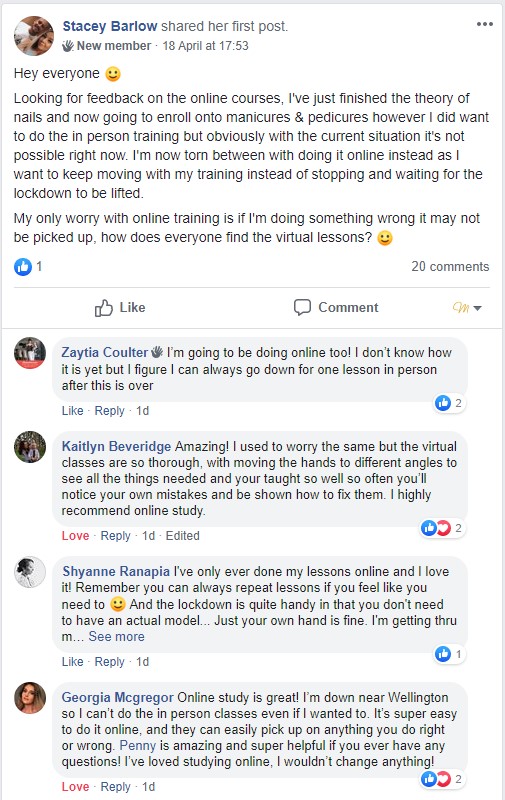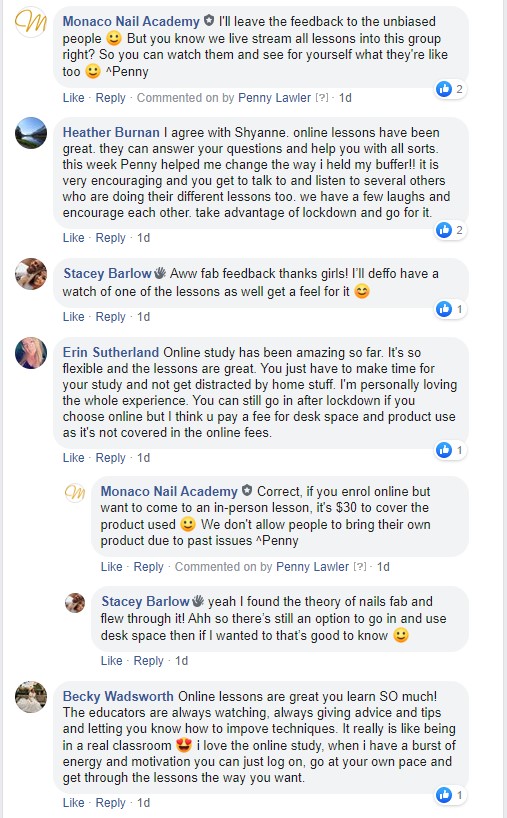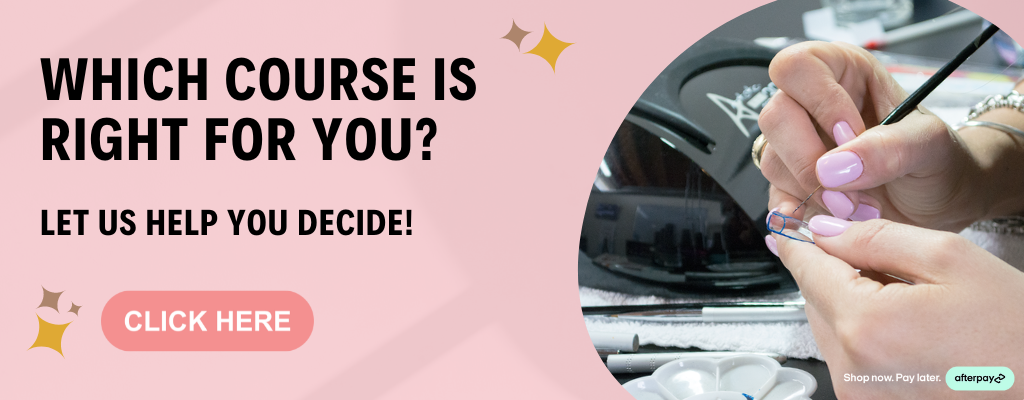The Theory of Nails Pre-Sept 2023(from
$99.00
)
Please Note – This course is not available to new enrolments.
For our current course offerings, please click here.
*** *** *** *** *** *** *** *** *** *** *** *** *** ***
Click to read our article ‘Top 5 Things to Consider When Choosing a Course’
The theory behind your art is even more important than the art and skill itself.
The Theory of Nails isn’t an E-Book, it’s a video and text-based E-Course. That means you can still read and enjoy it on your phone, tablet or computer (it’s best on a computer) but that we can also include videos, interactive quizzes and multimedia lessons along the way.
Every time we come up with new content to add to the workbook, you will get that update too. Your Online Workbook will never outdate or go stale – as technology changes, so will the information you have access to.
This Module is suitable for complete beginners with no experience.
During this Module we will cover –
- Client Consultations
- Hygiene
- Nail Anatomy
- Troubleshooting and Disorders
- UV Light
- Biohazards
- Chemical Hazards
- Common Product Ingredients and Safety When Using Them
- Introduction to Acrylates
- Polymers and Acrylate Characteristics
- Prescribing the Right Service for Your Clients
- Working with Nail Biters
Your fees include –
- 7+ Hours of Video Content. Pre-recorded videos allow the benefit of rewatching.
- 7-Day Support via our Facebook Group. We have a beautiful, unparalleled community of like-minded folk in there, ready to welcome you.
- 5-Day Support via Email and Phone.
- Unlimited attempts at your Written Assessment, also completed online.
This course does not include –
- Live Lessons. We keep the cost of our Short Courses down by not including any Live Lessons. You can choose to add these for $49 Per 3-Hour Group Session Or $80 Per Hour One-On-One
- A Portfolio Submission requirement.
- A Practical Exam requirement.
- A Kit. No product is required for The Theory of Nails.
How does it work?
Within 2 business days of enrolling, you will receive access to the online components of your course, which you can access by logging into this website. You can work through the content at your leisure. When you’re ready, book in for your Exam, also done via Zoom.
What if I’m not good enough?
Complete the detailed pre-recorded content and then choose to add live lessons if you WANT to, for $49 Per 3-Hour Group Session Or $80 Per Hour One-On-One
We require that you complete the online content first as it may answer many of your questions and solve many of the issues you are troubleshooting, leaving you able to make the most of your in-person session by only using it for skills you haven’t yet mastered. Your time with a Mentor is completely customised to suit your needs and have you leaving confident and ready to go!
Where are the courses held?
Our online courses are 100% Online including pre-recorded, live and exam components. Complete from your home or salon, no matter where you are.
Will I get a Certificate?
This Module is part of both the Introduction to Nail Technology and the Foundation Certificate in Nail Technology qualificationa. A Sticker to add to your Introduction or Foundation certificate is included with this course, available after all criteria are met.
If you would like a certificate additional or instead of the above-mentioned qualifications, you can purchase one for $15 in the ‘Certificates’ category of our online Shop. For short courses, this is an A5 Certificate, No foil. Our certificates reflect the amount of work put in, and Short Courses are really just Introductory.
Is there a Payment Plan?
If you’re on a budget, we recommend that you start with our Short Courses. You can pay using a credit card, bank transfer or LayBuy. We also have a ‘Pay As You Go’ version of some courses.
-
Introduction
You can skip this section if you do not plan on completing the full Foundation Certificate in Nail Technology
-
1 Admin
-
2 Client Consultations
- VIDEO LESSON – Client Consultations
- 2.1 Consultations = Customer Service
- 2.2 When the Client Arrives
- 2.3 Making Recommendations
- 2.4 Other Information to Gather
- 2.5 After the Appointment
- 2.6 Summing It Up
- 2.7 Sample Client Card
- 2.8 Consultations Activity (Optional)
- 2.9 Client Consultations Quiz (Optional)
- 2.10 We Don’t Believe in Homework But… (Part 1)
-
3 Sanitisation and Safety
- VIDEO LESSON – Sanitisation and Safety
- 3.1 Introduction to Basic Salon Sanitisation
- 3.2 When a Client Arrives (Wall Print Out)
- 3.3 Sanitisation and Disinfection of Tools and Implements
- 3.4 Correct Methods of Disinfection
- 3.5 When a Client Leaves (Wall Print Out)
- 3.6 Individual Client Packs
- 3.7 Added Responsibilities for Pedicure Equipment
- 3.8 Added Responsibilities for Blood and Bodily Fluids
- 3.9 Blood Spill (Wall Print Out)
- 3.10 Safe Use of Reusable Products
- 3.11 The Importance of Ventilation
- 3.12 First Aid
- 3.13 Ergonomics
- 3.14 Ergonomics Activity
- 3.15 Educating Clients
- 3.16 Self Evaluation 1 (Print Out)
- 3.17 Self Evaluation 2 (Print Out)
- 3.18 We Don’t Believe in Homework But… (Part 2)
-
4 Nail Anatomy and Disorders
- VIDEO LESSON Nail Anatomy
- 4.1 Introduction
- 4.2 Basic Nail Anatomy
- 4.3 Self Evaluation
- 4.4 Nail Anatomy Quiz (Optional)
- VIDEO LESSON – Disorders
- 4.5 Nail Disorders
- 4.6 Nail Pitting
- 4.7 Terry’s Nails
- 4.8 Beau’s Lines
- 4.9 Onycholysis
- 4.10 Yellow Nail Syndrome
- 4.11 Nail Clubbing
- 4.12 Koilonychia (Spoon Nails)
- 4.13 Paronychia
- 4.14 Onychomycosis (Nail Fungus)
- 4.15 Pseudomonas (Greenies)
- 4.16 Dermatophytes
- 4.17 Melanonychia
- 4.18 Nail Disorders Activity
- 4.19 Nail Disorders Quiz (Optional)
- 4.20 Nail Troubleshooting
- 4.21 Nail Troubleshooting Activity (Printable)
- 4.23 We Don’t Believe in Homework But… (Part 3)
-
Biohazards
- VIDEO LESSON Biohazards
- 5.1 What is a Biohazard?
- 5.2 The Risks
- 5.3 Steps to Prevent Exposure
- 5.4 What Should I Do If I Am Exposed To Bodily Fluids?
- 5.5 Biohazards Research Activity – PDF
- 5.6 Biohazards Quiz (Optional)
- 5.7 Blood Spill Drill
- 5.8 Blood Spill Drill Answers
- 5.9 We Don’t Believe in Homework But… (Part 4)
-
Chemical Hazards
- VIDEO LESSON – Chemical Hazards
- 6.1 Chemical Hazards
- 6.2 How To Reduce Exposure Due To Inhalation
- 6.3 How To Reduce Skin Exposure
- 6.4 Reduce The Risk Of Accidental Swallowing
- 6.5 The Risks of Exposure to Chemicals Via the Nail Plate
- 6.6 Checklist for Salons
- 6.7 Checklist for Employees
- VIDEO LESSON – Ingredients
- 6.8 Potential Symptoms and Health Effects of Overexposure
- 6.9 Methyl Methacrylate (MMA)
- 6.10 Vegan Products
- 6.11 Dragon’s Den UK Highlight the Difference Marketing Makes
- 6.13 MSDS Sheets
- 6.14 Artistic Nail Design and Be Creative MSDS Sheets
- 6.15 MSDS Activity
- 6.16 Chemical Hazards Quiz (Optional)
- 6.17 We Don’t Believe in Homework But… (Part 5)
-
UV Light
- VIDEO LESSON – UV Light
- 7.1 What is UV Light?
- 7.2 The Difference between LED and UV Lamps
- 7.3 The Dangers of Improper Curing
- 7.4 The Complexity of UV Curing by Doug Schoon
- 7.5 Do UV Lights Cause Cancer?
- 7.6 How Can We Increase Client Peace of Mind?
- 7.7 “Do UV Nail Lamps Emit Unsafe Levels of Ultraviolet Light?” – A Study
- 7.8 UV Quiz (Optional)
- 7.9 We Don’t Believe in Homework But… (Part 6)
-
Chemistry
- VIDEO LESSON – Acrylates
- 8.1 Plastics
- 8.2 Monomers
- 8.3 Polymerisation/Curing
- 8.4 Cross-Linking Monomers
- 8.5 Shrinkage
- VIDEO LESSON – Cyanoacrylates
- 8.6 Cyanoacrylates
- 8.7 Shock Curing
- VIDEO LESSON – Oligomers
- 8.8 Oligomers
- 8.9 Exothermic Reactions
- VIDEO LESSON – Polymers
- 8.10 Polymers
- 8.11 Liquid and Powder Ingredients Reference
- 8.12 Mix Ratios
- 8.13B Chemistry Activity (Printable Version)
- VIDEO LESSON – The Lifecycle of an Acrylate
- 8.14 Acrylate Characteristics
- 8.15 Adhesion
- 8.16 Wetting Agents
- 8.17 Flexibility
- 8.18 Strength
- 8.19 Removal
- 8.20 Choosing the Right Service for Your Client – Cheat Sheet
- 8.21 The Difference Between Artistic and Everyone Else
- 8.22 Chemistry Quiz (Optional)
- 8.23 We Don’t Believe in Homework But… (Part 7)
-
Bonuses
-
Assessment
-
Finished!
-
Sneak Peek: Manicures and Pedicures
This section is completely optional and is designed to give our Theory-Only Students a peek at what's next
- Manicures and Pedicures Lesson Guide
- Recommended Kit List – Manicures and Pedicures
- Welcome to the Manicures and Pedicures Module
- Virtual Classrooms
- What Products Will I Be Using?
- What to Look For in a Gel Polish Brand
- Natural Nail Prep – Video
- Natural Nail Prep – Written Steps
- Shaping The Natural Nail – Video
- Traditional Polish Manicure – Introduction
- Traditional Polish Manicure – Video
- Traditional Polish Manicure – Written Steps
- Traditional Polish Manicure – Self Evaluation
- Enrolling in Manicures and Pedicures


